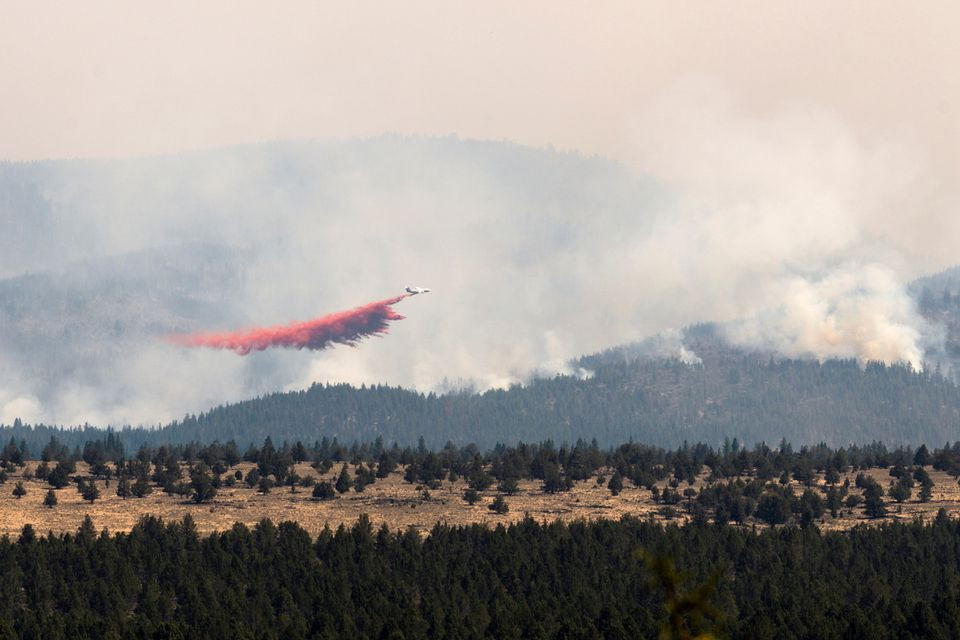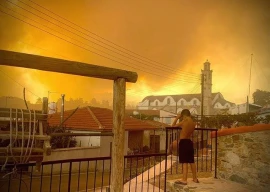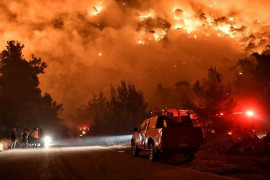
A sprawling wildfire raging mostly unchecked for over a week in southern Oregon forced firefighters into retreat for a fourth straight day as it expanded to become the state's fifth-largest blaze in more than a century, forestry officials said on Friday.
The Bootleg fire, the biggest among dozens of wildfires flaring across the tinder-dry landscape of the Western United States, has scorched more than 241,000 acres - an area exceeding the land mass of New York City.
Ironically, heavy smoke shrouding much of the region from the fires may act to slightly blunt the effects of yet another heat wave expected this weekend in the Rockies, extending to parts of Montana, Idaho, Wyoming, Utah and Colorado.
The Bootleg blaze has been burning through drought-parched timber and brush in and around the Fremont-Winema National Forest since erupting on July 6 near Klamath Falls, about 250 miles (400 km) south of Portland. The cause is under investigation.
Flames have destroyed at least 21 homes and 54 other structures, authorities said. On Friday, the Oregon Department of Forestry listed 5,000-plus homes as threatened, about 3,000 more than a day earlier.
That figure represents a greater number of communities potentially in harm's way as the blaze expands, said agency spokesman Marcus Kauffman. Still, fewer dwellings were in immediate danger, especially along the fire's southern flank where crews had more success.
Consequently, the number of homes under mandatory evacuation declined by about half to just over 200 on Friday, while about 2,700 were placed on stand-by alerts.
Strike teams have carved containment lines around 7% of the fire's perimeter. But extreme fire growth fueled by low humidity, dry vegetation and gusty winds forced firefighters to withdraw from leading edges of the blaze for a fourth consecutive day on Friday, officials said.
"The Bootleg fire perimeter is more than 200 miles long. That's an enormous amount of line to build and hold," incident commander Rob Allen said in a statement.
ANOTHER HEAT WAVE
Allen said hot, dry, windy conditions were expected to worsen over the weekend, while meteorologists forecast the arrival of yet another major Western heat wave, the fourth since early June.
This one, roasting portions of the Northern Rockies and High Plains through Monday, will emanate from a high-pressure ridge building over the Desert Southwest, said National Weather Service meteorologist David Lawrence.
That high-pressure dome may help pull some much-needed moisture into Arizona, California, Nevada, Utah and southern Idaho, Lawrence said. A potential downside, however, is the increased chance of dry lightning storms forming in central and northern California ahead of any rain that may fall there, he added.
More than 1,900 firefighters and a dozen helicopters as well as airplane tankers and bulldozers were assigned to the Bootleg fire as demand for personnel and equipment across the Pacific Northwest strained available resources.
The Bootleg ranked as the largest by far of 70 major active wildfires listed on Thursday as having burned more than 1 million acres in 12 states, the National Interagency Fire Center in Boise, Idaho, reported. It also stood as the fifth largest on record in Oregon since 1900, according to state forestry figures.
As of Wednesday, the center in Boise put its "national wildland fire preparedness level" at No. 5, the highest of its five-tier scale, meaning most U.S. firefighting resources are currently deployed somewhere across the country.
The situation represented an unusually busy start to the annual fire season, coming amid extremely dry conditions and record-breaking heat that has baked much of the West in recent weeks.
Scientists have said the growing frequency and intensity of wildfires are largely attributable to prolonged drought and increasing bouts of excessive heat that are symptomatic of climate change.
Nearly 70 National Weather Service stations across the West have posted all-time high temperatures this summer, and several hundred record highs for specific dates have also been set, Lawrence said
The Bootleg fire is so large that it generates its own weather. Towering pyrocumulus clouds form from condensed moisture that is sucked up through the fire's smoke column from burned vegetation and the surrounding atmosphere, and can spawn lightning and high winds.
The sudden "collapse" of one such cloud on Friday spread embers to the east of the main fire zone, prompting additional evacuation notices for two communities, Allen said.




1730464033-0/BeFunky-collage-(12)1730464033-0-165x106.webp)

1732445375-0/Untitled-design-(9)1732445375-0-270x192.webp)


1732428810-0/Copy-of-Untitled-(3)1732428810-0-270x192.webp)
1732425487-0/BeFunk_§_]__-(42)1732425487-0.jpg)









COMMENTS
Comments are moderated and generally will be posted if they are on-topic and not abusive.
For more information, please see our Comments FAQ